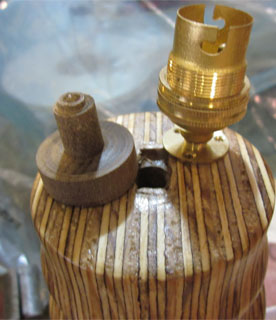Make light of it
Most wood turners have turned a table lamp at some time. This project gives practice in both spindle turning (the stem) and face-plate turning (the lamp’s base).
A large variety of woods are suitable for this project and the final product usually makes for a welcome gift or sells reasonably well at craft markets.
Plywood, however, is not normally considered a suitable material for turning; it describes a whole range of laminated woods of various types and qualities.
For this project I chose to use some sheets of 12mm 5-ply pine plywood from a packing case to see if something attractive could be made from rather unattractive material.
The description below does not contain much detail on quantities and sizes because no two products are ever going to be more than vaguely similar.

DIFFICULTY: Intermediate
ESTIMATED TIME: One day
COST: +/- R100.00
MATERIALS AND TOOLS:
- Pine plywood
- Sand paper
- Sanding sealer
- Twin-flew wire
- Three pin plug
- On/off switch
- Bulb fitting
- Wood glueJigsaw
- Lathe and turning chisels
- Drill and drill bits
- Screwdriver

One of the major problems when turning either a table or a standard lamp is making the hole through the stem for the electrical cord. Not all lathes allow for drilling the core hole through the tailstock with an auger bit. The alternative is to cut the block for the stem in half, use a table saw or a router to cut a core groove in the two halves and then rejoin carefully with glue. For this project the stem block is made by laminating a suitable number of layers of plywood, and the centre layer can be made to include a core groove.
Glue the pieces of plywood together.

Lots of glue should be used in the laminating and the core groove should be blocked at both ends by gluing in short pieces of a hard wood to act as centers for turning as seen on the right. The glued block should remain tightly clamped for several days to dry.
Glue in short pieces of a hard wood to act as centers for turning.

The stem block is now mounted securely in the lathe and turned to a suitable cylinder.
Mount the block in the lathe.

It is an advantage to make liberal use of sanding sealer to stabilise the plywood layers even before reaching a final profile.
Start turning the block into a cylinder. As you go along, apply sanding sealer to stabilise the plywood.

The choice of this profile will depend on each individual. I had intended to form a more elaborate profile, but the striped patterns of the plywood layers were very attractive and became even more so as the quality of the turned surface was improved by careful turning, application of more sanding sealer and sanding with increasingly fine grit paper.
Once the lamp’s stem is turned, sand with a fine grit sand paper and apply more sanding sealer.

Attention should be given to the two ends of the cylinder. The top end should be straightened and smoothed in preparation for the lamp bulb fitting and the bottom end should be worked on to ready it for connection to the base, usually a spigot to fit into a hole in the base.
Straighten and smooth the top and bottom ends of the cylinder.

The base is made in a similar fashion by laminating pieces of plywood suitable in size to support the lamp stem.
The lamp’s base is also made by gluing pieces of plywood together.

The base is turned using an expanding chuck in a drilled recess or screwed to a face plate.
The base is turned using an expanding chuck in a drilled recess.

A hole needs to be drilled through the edge of the base to the center to take the electrical cord. The top of the base is turned to accommodate the stem spigot. A hole must also be drilled though the blocking piece at the bottom of the core groove. If you decide to use the lathe as a clamp when gluing the stem and base together, the top blocking piece should not be drilled out until the joining has been done.
After the base is turned, glue the base and stem together. You can use the lathe as a clamp.

It is advisable to turn a small hardwood piece to fit into the top of the stem to take the screws of the bulb holder.
Turn a small hardwood piece to fit into the top of the stem to take the screws of the bulb holder. The hardwood piece goes into the top of the lamp stem.

The bottom of the base can be covered with a glued on layer of felt. The final step is to push some twin-flex wire through the hole in the edge of the base and up until it comes out at the top whereafter it can be attached to the bulb fitting. A three-pin plug and an on/off switch should also be added. Now the hunt can begin for a suitable lampshade to complement the patterns of the plywood.
Glue a piece of felt to the underside of the base to protect the furniture the stand is on.



Comments
Add comment